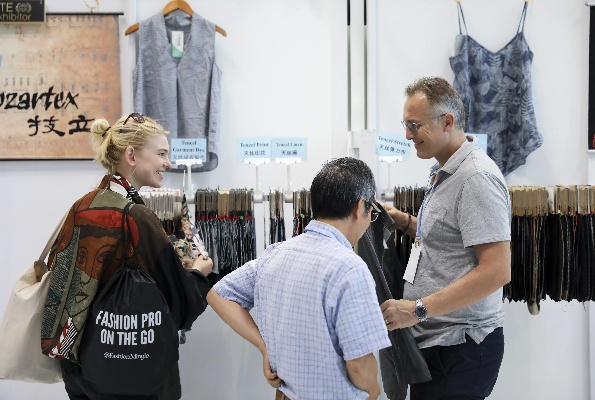Trends in Chinas Textile Market
In recent years, China's textile market has undergone significant changes. With the rapid development of globalization and the improvement of living standards, consumers have become more demanding in terms of quality and design. This has led to a shift in demand from traditional low-end products to high-end fashionable ones. Additionally, the rise of e-commerce platforms has greatly facilitated the distribution and marketing of textile products, making it easier for small and medium-sized enterprises (SMEs) to enter the market. However, this also poses challenges such as product quality control and supply chain management. In response to these challenges, some SMEs are now focusing on developing their own brand and improving their technological capabilities to enhance their competitiveness in the market. Overall, the future development of China's textile market is expected to be driven by innovation, technology, and consumer demands.
Introduction: The textile industry is one of the most important sectors in China, contributing significantly to its economy and employment. As a global leader in manufacturing, China's textile market is constantly evolving, driven by factors such as technological advancements, changing consumer preferences, and international trade policies. In this article, we will explore the current trends in China's textile market, including the growth of e-commerce, the rise of sustainable materials, and the increasing importance of fashion design. We will also present an illustrative table to help readers understand these trends better.
Growth of E-commerce: With the rapid development of the internet, e-commerce has become an increasingly important part of China's textile market. According to a recent report by the China National Bureau of Statistics, online sales accounted for 25% of total textile sales in 2019, up from 18% in 2018. This trend is expected to continue, with more consumers turning to online shopping for their textile needs.
Sustainable Materials: Environmental concerns are driving the adoption of sustainable materials in China's textile industry. The government has implemented various policies to promote the use of eco-friendly fibers and dyes, such as reducing the use of pesticides in cotton farming and promoting the use of recycled polyester. These efforts have led to increased demand for organic and biodegradable textiles.

Fashion Design: In recent years, fashion design has become an important factor shaping China's textile market. With the emergence of new design concepts and innovative technologies, Chinese designers are gaining recognition both domestically and internationally. For example, Hangzhou's Xu Xiaolin, known for his minimalist designs that incorporate natural materials, has established a strong presence in the international fashion world.
Case Study: One example of the impact of sustainable materials on China's textile market is the success of Tencent Textiles, a company specializing in the production of eco-friendly and sustainable textiles. Since its establishment in 2016, Tencent Textiles has developed a range of products made from recycled polyester and bamboo fibers, which are highly sought after by consumers looking for eco-friendly alternatives. The company's commitment to sustainability has helped it establish itself as a leading player in the green textile industry.
Conclusion: The future of China's textile market looks bright, with continued growth in e-commerce, the adoption of sustainable materials, and the influence of fashion design. As technology continues to advance and consumers become more environmentally conscious, it is likely that these trends will shape the industry even further. It is essential for manufacturers and retailers to stay ahead of the curve and adapt to these changes in order to succeed in the competitive global market.
近年来,我国纺织品市场呈现出诸多趋势,这些趋势不仅反映了市场的发展动态,也反映了消费者需求的变化,本文将通过分析当前市场趋势,探讨未来纺织品市场的走向。
市场现状
市场规模不断扩大
随着经济的持续发展和人民生活水平的提高,我国纺织品市场规模不断扩大,从服装、家居纺织品到户外运动用品,各类纺织品产品种类繁多,市场潜力巨大。
消费者需求多元化
随着消费者对纺织品品质、功能、环保等方面的要求不断提高,消费者需求呈现出多元化趋势,消费者更注重产品的舒适度、时尚感、环保性等。
市场趋势分析

绿色环保趋势明显
随着环保意识的提高,绿色环保成为纺织品市场的重要趋势,越来越多的消费者开始关注产品的环保性能,选择符合环保标准的纺织品产品,政府也在推动绿色纺织品的生产和消费,为纺织品市场带来新的发展机遇。
高端化、个性化趋势明显
随着消费者对纺织品品质和功能的追求不断提高,高端化、个性化趋势越来越明显,消费者更愿意为高品质、高功能的纺织品支付更高的价格,品牌化、定制化也成为纺织品市场的重要发展方向。
智能化、数字化趋势发展
随着科技的不断发展,智能化、数字化趋势也在纺织品市场中得到快速发展,智能化技术如物联网、大数据等的应用,为纺织品生产、销售、服务提供了新的方式,数字化技术如电子商务、智能供应链管理等的应用,也提高了纺织品市场的效率和透明度。
案例说明
以某地区为例,近年来该地区纺织品市场呈现出以下趋势:
绿色环保产品受欢迎
该地区的一家知名纺织企业推出了一系列绿色环保产品,受到了消费者的热烈欢迎,该企业注重产品的环保性能,采用环保材料和生产工艺,同时注重产品的舒适度和时尚感,满足了消费者的多元化需求。
品牌化、定制化趋势明显

随着消费者对纺织品品质和功能的追求不断提高,品牌化、定制化趋势越来越明显,该地区的一些大型纺织企业开始推出定制化的纺织品产品,满足消费者的个性化需求,这些企业也加强了与设计师的合作,推出了一系列具有独特设计和风格的纺织品产品。
未来我国纺织品市场将继续呈现以下趋势:
绿色环保趋势将继续发展
随着环保意识的提高和政府政策的支持,绿色环保将成为纺织品市场的重要趋势,更多的企业将注重产品的环保性能,推动绿色纺织品的生产和消费。
高端化、个性化趋势将继续发展
随着消费者对纺织品品质和功能的追求不断提高,高端化、个性化趋势将继续发展,更多的品牌和企业将推出高品质、高功能的纺织品产品,满足消费者的多元化需求,个性化定制也将成为纺织品市场的重要发展方向。
智能化、数字化趋势将更加深入发展
随着科技的不断发展,智能化、数字化趋势将更加深入发展,纺织品市场将更加注重智能化技术的应用,提高生产效率和服务水平,数字化也将成为纺织品市场的重要营销手段,提高市场的竞争力和透明度。
Articles related to the knowledge points of this article:



